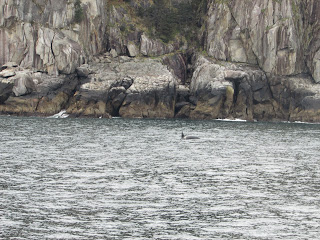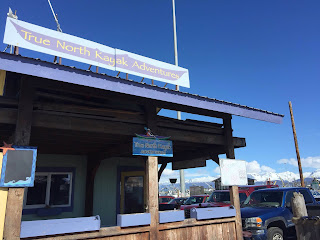Today was dedicated to giving back a little to the
Alaskan community. A majority of our morning and afternoon was spent working
with Moore’s Landscaping on a restoration project located on the Kenai River.
The main purpose of this project was to better the river’s condition by
fighting against erosion created by boat traffic. However, secondary benefits
such as new habitat for juvenile/small fish species were created as well as
better suited locations for recreational fishing. The project itself involved
creating a bed of dead spruce branches, digging a small trench along its edge,
inserting “logs” followed by willow twigs, and finally sealing the twigs in
with a thick layer of dirt. This project is expected to last up to 30 years
with regular maintenance and will play a role is preserving the wildlife seen
in the beautiful rivers of Alaska.


Worry not, the day was not all sweat and tears! We
were graciously treated with pizza and cookies by the workers of Moore’s
Landscaping before returning to the cabins and learning some general
information about climate and the characteristics of each biome type.
Dr. Smith briefly spoke about many factors influencing
climate including the earth’s energy balance, effects of plant life, tilt of
the earths’ axis, and the general movement of air based on temperature. We then
spoke in depth of the characteristics of each biome type. There are 9 biome
types in total which are classified by plant life, temperature, and
precipitation.
Tundra
· Temperature:
Below freezing most of the year
· Precipitation:
Low overall, slightly higher in the summer
· Vegetation:
Small plants rather than trees
Boreal
Forest/Taiga
· Temperature: Below
freezing most of the year
· Precipitation:
Low to medium, higher in
summer
· Vegetation: Mostly
evergreen, fires are common
Temperate coniferous forest
· Temperature:
distinct season
· Precipitation:
medium overall, highly variable, higher in summer
· Vegetation:
mostly evergreen trees, fire are common
Temperate deciduous forest
· Temperature:
distinct season
· Precipitation:
medium overall, slightly higher in summer
· Vegetation:
mostly deciduous trees, losing leaves saves energy in winter
Temperate scrubland
· Temperature:
distinct season
· Precipitation:
medium overall, higher in winter
· Vegetation:
shrubs that survive hot dry summer, evergreen
Temperate grassland
· Temperature:
distinct season
· Precipitation:
high in summer, lower in winter than other temperate biome
· Vegetation:
few trees or shrubs grasses
Tropical Rainforest
· Temperature
: high year around
· Precipitation:
high overall, may vary or be constantly high
· Vegetation:
mix of trees, often varies height
Tropical seasonal forest
· Temperature
: High around year
· Precipitation:
wet and dry season
· Vegetation:
varies widely- forest, scrublands, savannas
Desert
· Temperature:
distinct season, but rarely below freezing
· Precipitation:
low overall
· Vegetation:
small, spark plants, often succulent
Leslie Hixon and Chandra Chamalagai
























